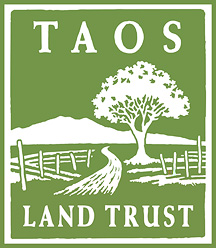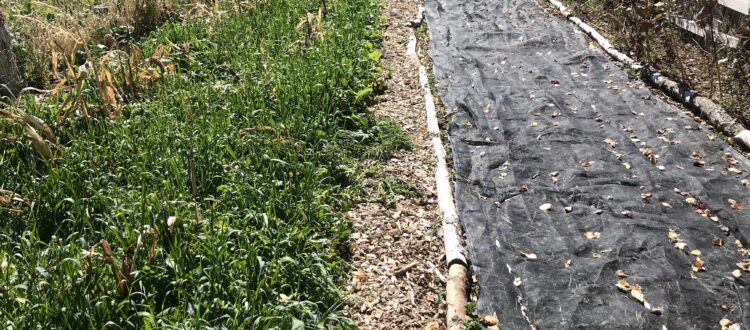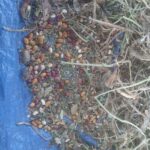Some Thoughts on No-Till Farming
by Gwendolyn Pieper
Conventional agriculture has taught us that mechanical tillage is our friend. It tells us that we must have bare fields, monocrops, and chemical inputs. But it turns out that these practices are destroying the health of our communities, our soil, and our planet. It is time to learn a new way of farming, or perhaps an old way–a way that nature has been trying to teach us since the beginning.
But first, you may be curious why tilling is such a problem. Over time, tillage wreaks havoc on the health of the soil and all of the critters that support a flourishing and productive farm ecosystem. Tilling breaks apart the complex soil structure that is the result of years of collaborative work between plant roots, microbes, and fungi. This structure is made up of what are called aggregates, small clumps of mineral and organic particles that are held together by roots, fungi, earthworm residues, and microbial glues. These stable aggregates are critical to healthy soil because they create a diversity of pore spaces that make it easier for water to infiltrate and stay in the soil. Tiller blades break up these precious aggregates and leave your soil vulnerable to all sorts of problems, like erosion, compaction, and nutrient leaching. It’s like taking a wrecking ball to a cathedral and expecting it to put itself back together the next day.
Tillage also breaks down organic matter, depleting it year after year and releasing CO2 into the atmosphere. Obviously releasing more greenhouse gasses is a bad thing, but why is losing organic matter an issue? Organic matter is a key ingredient in healthy soil. It is the medium that helps the soil hold and release nutrients, provides food for all of the soil organisms that help plants grow, enhances water infiltration and aggregate formation, stores carbon, and ultimately, is the best indicator of success for crops. Organic matter is responsible for that beautiful dark color that we associate with a rich, fertile soil–it’s like chocolate cake for plants! Intensive tillage is like eating all of that cake at once then having to live off of the crumbs for years to come. But healthy crops need more than just crumbs, they want cake all the time.
So how do we give them all of the chocolate cake they want? Well, we have to give them a constant supply of nutrients. When we remove crop residues, till, and leave a field bare, we are starving the soil. But when we maintain a diversity of roots in the soil year-round by growing cover crops, we are adding back all of the ingredients for making that rich chocolate cake. Growing a diversity of plants is critical. If we only grow one crop, it’s like trying to bake that cake using only flour. We need all of the ingredients! This means choosing cover crops from each of the four main groups: legumes, brassicas, broadleaf, and grasses. Growing a diversity of cover crops supplies the soil organisms with all of the ingredients necessary to start baking cake.
The picture below exhibits a soil with representatives from each of the four cover crop categories. This soil is full of living roots, rich with dark organic matter and teeming with microbial life! But we’d need a microscope to see that.
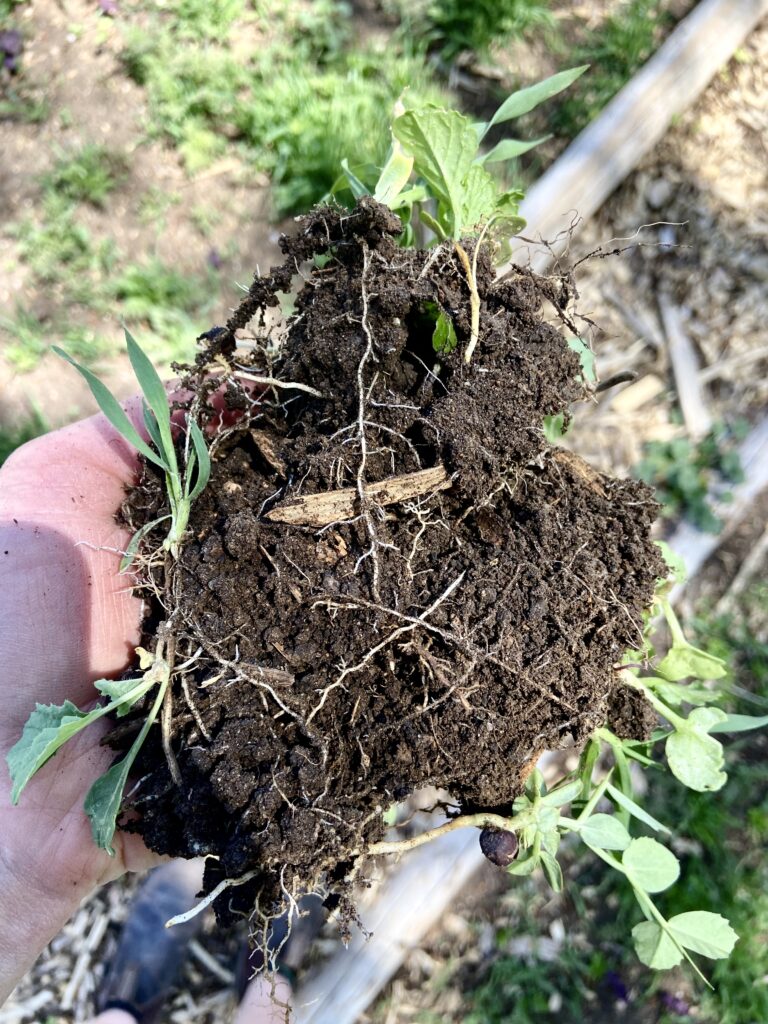
In order to keep building up that supply of goodness in the soil, it’s important to reduce tillage or transition to no-till farming. Growing diverse cover crops both helps to reduce the need for tillage and remedy the harmful impacts of tillage on the soil. The roots of cover crops help to loosen compaction, create channels for water and air, form symbiotic relationships with helpful bacteria and fungi, help hold the soil in place against erosion, and improve the soil structure. Living plants actively feed the microbial community in the soil by sending out sugars in the form of root exudates to their bacterial and fungal partners, who send them nutrients in exchange. When these plants die, they continue to feed their underground community by releasing their nutrients and biomass back into the soil, to be decomposed by microbes and transformed into fertile organic matter. Flowering cover crops also provide nectar for pollinators and habitat for beneficial insects and natural enemies of pests. When we add cover crops and don’t remove them, we are completing an essential nutrient loop that builds soil fertility and supports the mutualistic relationships that sustain a flourishing farm ecosystem.

The picture above shows a bed that has been cover-cropped in between cash crops. When it is time to plant, this crop can be terminated using a wheel hoe (at small scales. Other means of termination can be used at larger scales and a seed-drill used for no-till seeding). Pictured below is what this bed looks like after wheel-hoeing. When you hoe, it is a gentler and shallower form of tillage, that minimizes the impact on the structure and biology of the soil. It’s a good idea to keep those cover crop residues and use them as green mulch to cover the bed and prevent the soil from drying out after planting.
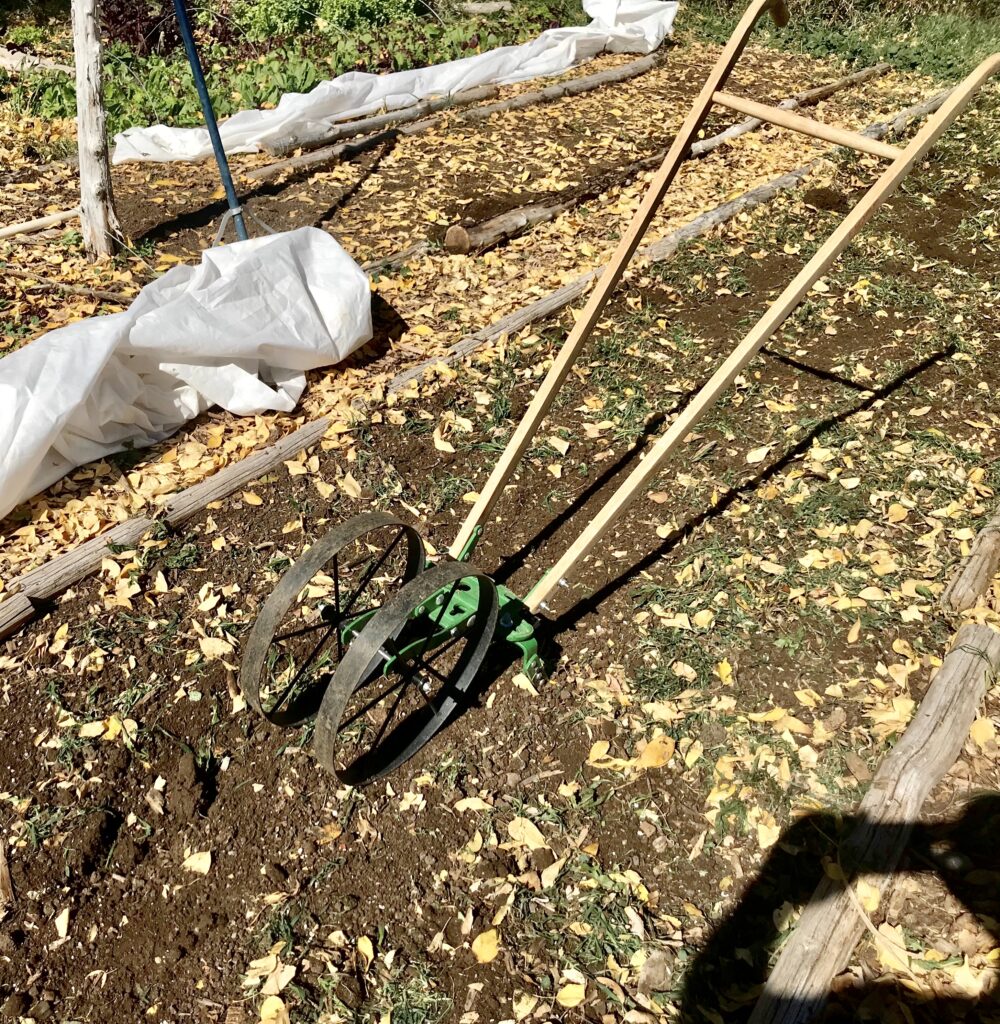
By implementing these practices, our soils remain covered throughout the year, allowing them to develop the biology, structure, and diversity that are critical for soil to optimally function and support plant life. If you think about it, nature has always shown us this way of farming. Have you ever seen a temperate ecosystem with bare soil, devoid of life except for one species of plant? By keeping the soil covered year-round, reducing mechanical disturbance, and growing cover crops to support a diverse community of organisms, we are creating the very conditions that nature has prescribed for a healthy ecosystem. We need to leave the conventional paradigm behind, which dictates order and monoculture, bareness and lifelessness, extraction and tilling. We must change what we think a garden “should” look like, and think about what an ecosystem really wants to look like.
##
